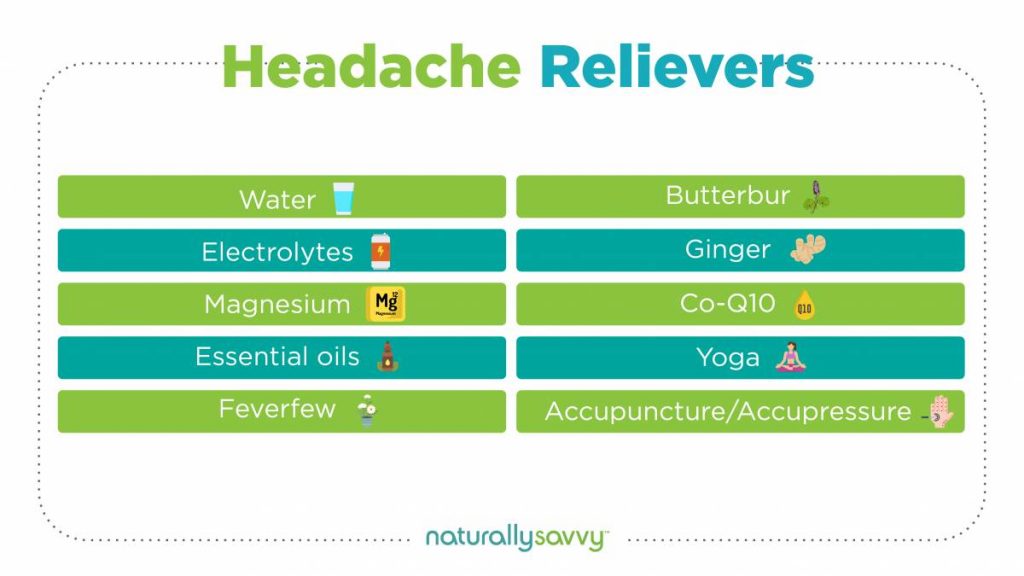
If you have never had a headache, congratulations! But for nearly everyone else, headaches happen, and there are plenty of drug-related ways to prevent and treat them. However, why risk side effects and toxicity from medications when you can go au natural?
People have been treating headaches naturally for thousands of years. Some of the methods have withstood the passage of time while others have emerged on the scene more recently or been studied scientifically and found to be effective.
Read about 13 things that might be causing your headaches
With that introduction, let’s explore some natural headache remedies.
Acupuncture/Acupressure
You may want to try Traditional Chinese Medicine and travel the meridians (energy pathways) to relieve headache and migraine pain. Acupuncture, for example, has been shown to be similar in effectiveness to common migraine prophylactic (preventive) medications, according to the findings of a 22-study review. The evidence also suggests that using acupuncture along with symptomatic treatment of migraines can reduce headache frequency.
Acupressure also addresses the flow of energy through your meridians. This technique involves applying pressure with your index fingers to the area between your eyebrows. Using a circular motion, rub the spot for about one minute. Another acupressure point lies between your index finger and thumb. Apply pressure near the base of your thumb for about five seconds, then release. If this is difficult a small wearable can help.
Butterbur
This shrub has anti-inflammatory properties that may help fight migraines. Doses of 50 to 150 mg have been shown to reduce headache symptoms. When choosing butterbur supplements, be sure to get a purified product, because unpurified forms can damage your liver.
CoQ10
Coenzyme Q10 (CoQ10) is generally known as being a heart-friendly supplement. However, several studies have shown that taking CoQ10 can also assist with migraines. In fact, a study of 80 individuals showed that a dose of 100 mg daily proved to be effective at reducing the severity, length, and frequency of migraines. A smaller but more aggressive study found that 100 mg CoQ10 taken three times a day reduced frequency and nausea in nearly half of treated individuals compared with 14 percent of those who took a placebo.
Electrolytes
Electrolytes are minerals (e.g., sodium chloride, magnesium, potassium, calcium) that have an electrical charge. When they are out of balance in the body, usually due to dehydration, headache and migraine may occur. To help prevent and treat headaches and migraines, be sure to replace low electrolyte levels by drinking a beverage that contains these essential elements. [Editor's Note: We love SOS Hydration because it is low in sugar and calories but as effective as an IV drip in helping keep you hydrated.]
Essential oils
The aromatic compounds (essential oils) found in many plants have the ability to ease headaches and migraine pain. Inhaling the aroma of lavender and peppermint, for example, can reduce tension headache and migraine symptoms. Place a drop or two on your upper lip or a cotton ball and inhale. Some get relief by rubbing peppermint oil into their temples or the back of the neck.

Feverfew
Feverfew has long been a natural remedy for the management of migraines. The herb contains parthenolide, a chemical that reduces factors in the body that may cause migraines. A 2019 report noted that this herb, with its anti-inflammatory properties, is “probably effective” against migraines. An effective dosage range maybe 50 to 150 mg.
Ginger
You might think of ginger as being great for digestion, and it can be. But did you know it also can relieve headache pain? A study appearing in Phytotherapy Research reported that ginger powder (250 mg) was comparable to sumatriptan (a common prescription for migraine) in relieving common migraine attacks. People who used ginger also experienced fewer side effects. You can use ginger tea rather than a supplement if you prefer.
Read about 9 uncommon things that can trigger a migraine
Magnesium
Among the many benefits, one can derive from this mineral is relief from headache pain. According to a 2020 report, “Migraine is usually related to low amounts of Mg [magnesium]” and “Mg has been extensively used in migraine prophylaxis and treatment.” The American Migraine Foundation suggests an oral dose of 400 to 500 mg magnesium daily to prevent migraines. We prefer the better-absorbed form of magnesium glycinate or magnesium l-threonate that can cross the blood-brain barrier.
Water
Did you know that not staying adequately hydrated can cause both migraines and tension headaches? We get it: you forget your water bottle at home, you work out and don’t take the time to drink enough water, you’re so busy at work it slips your mind to take a sip.
But chronic dehydration can be a real pain in the head. Both prevent and treat headaches by drinking about eight or more glasses of water daily and eating water-rich foods.
Yoga
Have you ever done the downward-facing dog pose? This yoga position is just one of several that can help relieve stress, reduce pain, and lessen the frequency and intensity of headaches. The practice of yoga has the ability to relieve chronic headache pain. One study found that the frequency and intensity of chronic migraines were reduced more among participants who engaged in both conventional therapy and yoga than those who did conventional care only.
Bottom Line
Do you experience tension or migraine headaches and want to find effective natural remedies? Then look no further; these options have been shown to provide relief from your head pain.










